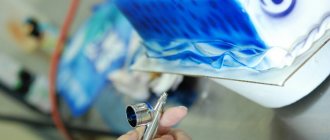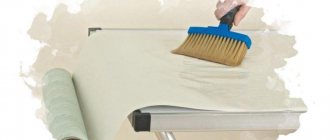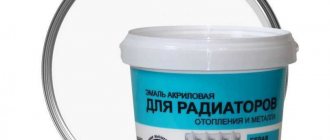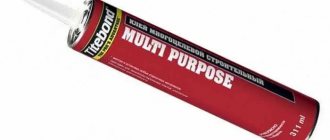Updated: 04/23/2021 15:30:06
Expert: Konstantin Borisovich Polyakov
*Review of the best according to the editors of expertology.ru. About the selection criteria. This material is subjective in nature, does not constitute advertising and does not serve as a purchase guide. Before purchasing, consultation with a specialist is required.
When performing finishing work in the bathroom, you cannot do without a material such as sealant. Using this product, seams between tiles are sealed, joints between plumbing fixtures and walls are insulated, decorative skirting boards are attached, etc. The need to fill voids with sealant is explained not only by aesthetics, but also by the need to protect the surface from moisture and microorganisms. Today there is a large assortment of specialized formulations on sale from different manufacturers. When choosing the best bathtub sealant, there are a few important things to consider.
Criteria for choosing a bathtub sealant
- The bathroom or shower creates excellent conditions for the emergence and proliferation of microorganisms. High humidity and warm air promote the development of fungi, mold and other biological formations. Therefore, the composition must become a reliable barrier for microorganisms.
- For many finishing craftsmen, the most important property of a sealant is simplicity and ease of application. Viscous gel-like materials that completely fill any voids deserve special praise.
- A very unpleasant moment for owners of houses and apartments will be a violation of the integrity of the insulation (cracking, peeling). To restore the attractiveness of the cladding, you have to clean the tile joints and apply a new compound. Therefore, after drying, the seam must be elastic, durable and firmly adhere to the surface.
- In country houses where there is no heating in winter, the bathroom should be finished with frost-resistant materials. The sealant should have the same property.
Our review includes the best bathtub sealants. When compiling the rating, the following criteria were taken into account:
- ease of use;
- resistance to biological damage;
- price;
- expert opinion;
- consumer reviews.
What to do if mold returns
It happens that even after quality measures have been taken to get rid of mold and seal all joints and seams, the problem reappears. In this case, you will have to find a source of fungal growth, which, as a rule, is located under the tiles, in the deep layers of the seam, where the sealant did not get into, or other hard-to-reach places. In such a situation, you will have to completely clean the surface of the sealing material as follows:
- take a utility knife and carefully cut the silicone or acrylic on both sides of the seam;
- pick up the sealant and pull it out of the groove entirely, then immediately throw it away;
- clean debris, dirt, dust from the seam with a knife;
- disinfect the problem area with isopropyl alcohol or anti-mold compounds 2-3 times;
- let the joint dry (usually a day is enough);
- reapply sanitary sealant with anti-mold additives.
Table of advantages and disadvantages of different types of bathtub sealants
| Types of sealants | Advantages | Flaws |
| Acrylic | + low price + moisture resistance and resistance to temperature changes + can be painted + excellent adhesion to different materials | - insulation is not elastic — hardens for a long time (24 hours) - not all products are suitable for the bath |
| Sanitary | + high resistance to biodestruction + wide scope of application + good adhesion + minimal shrinkage | - pungent odor lasts for a long time - high price |
| Silicone | + affordable price + resistance to water, temperature changes, ultraviolet rays + wide range of colors + also suitable for outdoor use | - cannot be painted — insufficient adhesion to polymeric materials. |
| Polyurethane | + fast hardening + can be used as an adhesive + elastic and durable insulation + can be coated with paint or varnish | - high price - poses a danger to the health of the finisher during work |
How long does it take for the insulating compound to dry?
The drying period of the sealant in conditions of high humidity depends on the components included in the sealant, as well as its quality.
- Silicone-based acid compounds dry out faster - 4-6 hours. But it is not recommended to use the mixture for metal products, as corrosion may form.
- The universal sealant, 0.2 cm thick, dries in 24 hours, but only at above-zero temperatures.
- When processing seams between the wall surface and the bathtub, a thick layer of sealant is often laid. Therefore, you should not look at the drying period of the mixture indicated by the manufacturer on the packaging. Practice shows that the duration of this procedure often reaches two days.
How to speed up the drying of bathroom sealant:
- Raise the ambient temperature to 40º.
- Ensure ventilation of the room by opening doors and windows in the apartment, and turning on the hood in the bathroom.
- Spray the sealed seams with water using a spray bottle. Moisture accelerates the polymerization procedure of the sealant.
Advice! Do not immediately apply two layers of the substance to one joint. The layers will lag behind each other. It is better to immediately apply a layer of sealant of the required thickness.
Rating of the best bath sealants
| Nomination | place | Name of product | price |
| The best acrylic sealants | 1 | Ceresit CS 7 | 290 ₽ |
| 2 | Moment Germent | 449 ₽ | |
| The best sanitary sealants | 1 | MAKROFLEX SX101 | 252 ₽ |
| 2 | Tangit SPECIAL S400 | 189 ₽ | |
| 3 | Belinka Belsil Sanitary Acetate | 216 ₽ | |
| The best silicone sealants | 1 | CIKI FIX universal | 120 ₽ |
| 2 | KRASS silicone universal | 199 ₽ | |
| 3 | Ceresit CS 25 | 290 ₽ | |
| The best polyurethane sealants | 1 | Tytan Power Flex | 480 ₽ |
| 2 | Rubberflex PRO PU 25 | 298 ₽ |
The Best Acrylic Bath Sealants
Experts consider acrylic sealant to be one of the most convenient insulating materials to use. It perfectly fills voids between materials such as stone, ceramics, brick and concrete. The product allows you to reliably glue plastic skirting boards in the bathtub, as well as grout wide seams. The following compositions attracted the attention of experts.
Ceresit CS 7
Rating: 4.9
One of the most popular acrylic sealants in Russia is the composition of Ceresit CS 7. Experts also highly appreciated the capabilities of the material, giving it first place in the rating. Particularly noteworthy is the quality of the high elasticity of the seam after drying. The sealant goes well with different construction paints, so after drying the seam can be painted in your favorite color. Experts call the strengths of the material moisture resistance and resistance to temperature changes.
Beginners when working with Ceresit CS 7 acrylic sealant must follow the manufacturer’s recommendations. Particular attention should be paid to the thickness of the seam; too large a layer may crack after drying.
Advantages
- elastic seam;
- moisture resistance and resistance to temperature changes;
- painting of the seam is allowed;
- reliability and durability.
Flaws
- a thick seam may crack.
Preparatory work
If the joints are sealed after the completion of a new repair, the preparation measures are simple. It is necessary to remove all remaining dirt, construction dust, and erase stains. Surfaces to which the sealant will be directly applied must be degreased by washing with detergents or wiping with alcohol or acetone.
When sealant has previously been applied to joints and seams, the old material will first have to be completely removed. You need to act especially carefully if it turns yellow or begins to turn black: mold has already appeared, and you should get rid of it without leaving a trace. To clean the base, use a rubber spatula and a stationery knife. Carefully separate the edges of the seam from the surface, then tear them off or pick them out in pieces, as necessary. In difficult cases, chemical removers in the form of sprays or softening pastes are used. Some of them can damage finishing materials, so first carry out the test on an inconspicuous area.
The Best Sanitary Bath Sealants
The most effective way to prevent biological damage in the bathroom is sanitary sealant. The product not only aesthetically creates seams and joints in the bathroom. It contains special fungicides that kill microorganisms. Here are some reliable sanitary bathtub sealants.
MAKROFLEX SX101
Rating: 4.9
The sanitary sealant MAKROFLEX SX101 has the highest antiseptic qualities. The material deservedly became the winner of the rating; such properties as high adhesion, moisture resistance and resistance to temperature changes were highly praised. The composition is specially designed for filling voids in a bathhouse, shower or bathroom. The manufacturer has introduced special fungicides into the recipe that prevent the appearance of mold and fungi.
Users note the resistance of the formed seam to sunlight and ozone. Due to its frost resistance, the material can be used to seal refrigerators and freezers.
Advantages
- good adhesion;
- moisture resistance and resistance to temperature changes;
- effective antiseptics and fungicides;
- UV and ozone resistance.
Flaws
- specific smell.
Causes of mold
Black mold is a common problem in the bathroom. This microorganism belongs to fungi and spreads throughout the house through spores - microscopic particles that fly freely around the rooms. Most often, mold appears near the bathtub, shower, in seams, between the wall and plumbing - where moisture regularly accumulates. Without emergency measures, mold spores can penetrate into other rooms and appear on windows, in the kitchen and other damp places. They are inhaled by humans, harming their health, causing lung diseases and allergies.
The main reason why bathroom walls become moldy is excessive moisture. Particularly favorable conditions for mold are created by leaking taps, wet laundry, and lack of regular room ventilation. If there is no good ventilation, the fungi multiply even more actively. Additional risk factors for mold development include:
- poorly insulated, freezing walls;
- insufficient sealing of seams between tiles and panels;
- low quality finishing materials;
- lack of sunlight (UV rays kill mold).
The Best Silicone Sealants for Bathtubs
Silicone sealants are available in acid or neutral base. Vinegar-smelling products can be used on a wide range of surfaces, with the exception of metal. The neutral composition is distinguished by its versatility of use, but its cost is higher. The following silicone materials are included in our rating.
CIKI FIX universal
Rating: 4.9
CIKI FIX universal silicone sealant has a death grip. The composition received such high praise from domestic cladding manufacturers. In terms of adhesion ability, the material surpasses all competitors. This factor became decisive in determining the winner of the rating. Such properties of the product as elasticity of the seam and moisture resistance did not escape the attention of experts. Even with frequent use of the shower or bath, the sealant does not wash out or crack.
The strengths of CIKI FIX are its resistance to temperature changes. The product is also tolerant of painted surfaces. But the lack of antifungal components in the composition requires constant ventilation of the bathroom.
Advantages
- increased adhesion;
- moisture resistance;
- elasticity;
- resistance to temperature changes.
Flaws
- poor resistance to biodestruction.
Folk remedies for mold
All means are good in the fight against mold. To save money, many do not buy expensive fungicides in the store, but use proven folk recipes. Here are the most popular:
- Purchase a solution of borax (sodium tetraborate). Dilute a glass of the product with 2.5 liters of water, and use a toothbrush to thoroughly treat the fungus-affected surfaces in the bathroom. The composition does not need to be washed off; it forms a protective film.
- Stir a teaspoon of tea tree oil into a glass of water. Apply the solution to moldy areas, leave for 2 hours, then rinse them.
- Sprinkle all areas with mold with table vinegar (9%), and do not dilute it with water. Rinse off the vinegar after 1 hour with a cloth.
- Moisten a foam sponge with water, dip it in soda, and clean seams, joints, and walls affected by fungus. You can also rub baking soda into the bases with a stiff brush. After an hour, the product should be washed off.
- Take hydrogen peroxide and treat moldy areas. In this way, you can even bleach old silicone seams that have become darkened by fungus over time.
The best polyurethane sealants for bathtubs
One of the most modern types of bathtub sealants are polyurethane-based compounds. The products do an excellent job of insulating joints in glass, wood, stone, concrete, and ceramics. The seam hardens quickly and is resistant to microorganisms, moisture and temperature changes. Experts singled out two products from the total mass.
Tytan Power Flex
Rating: 4.9
Polish polyurethane sealant Tytan Power Flex is a professional insulating material. Experts confirm flattering user reviews regarding high performance properties. The product deserves the highest level in our rating. Among the many positive qualities, experts highlight the elasticity and strength of the formed insulation layer. The sealant is equally good at filling tile joints or eliminating voids in plumbing fixtures.
There is one more feature of the composition; it can be used to restore old seams or joints. Thanks to reliable adhesion, durability and the possibility of painting, the consumer can fit the new panel into the interior of the bathroom at minimal cost.
Advantages
- high quality;
- elastic and durable seam;
- possibility of restoration of old connections;
- high adhesion.
Flaws
- high price.
Rubberflex PRO PU 25
Rating: 4.8
The one-component composition Rubberflex PRO PU 25 is not very well known in our country, although its qualities are worthy of attention. It’s not for nothing that experts gave this polyurethane sealant second place in the rating. Experts attribute the increased elasticity of the seam to the strengths of the product. After the layer dries, high-quality insulation is formed. The composition can be used when installing plumbing fixtures or for decorating tiled surfaces.
Users speak flatteringly about the product’s resistance to negative atmospheric conditions. The composition can be used both for interior work and for finishing external surfaces. To highlight the beauty of the interior, the insulation layer can be painted in a suitable color. If the seam is damaged, the integrity can be easily restored with the same sealant.
Advantages
- elastic seam;
- resistance to precipitation and sunlight;
- no shrinkage.
Flaws
- rarely on sale;
- high price.
Mold prevention
In order not to encounter mold growth in the bathroom again, even after sanitizing and applying sealant, a number of preventive measures must be followed. To begin with, it is imperative to equip a high-quality ventilation system, at the same time regularly ventilating the room. Otherwise there will always be high humidity there. Dripping faucets, leaking gaskets, and broken shower heads need to be repaired or replaced.
If the walls freeze, you will have to insulate them, otherwise the fungus will begin to populate the room again. To prevent mold from getting into the bathroom from neighbors, all cracks, gaps and cracks should be well sealed, and a good antifungal sealant will also come in handy here. These measures will seriously reduce the risk of the adverse effects of mold on the human body and the destruction of finishing materials in the bathroom.











